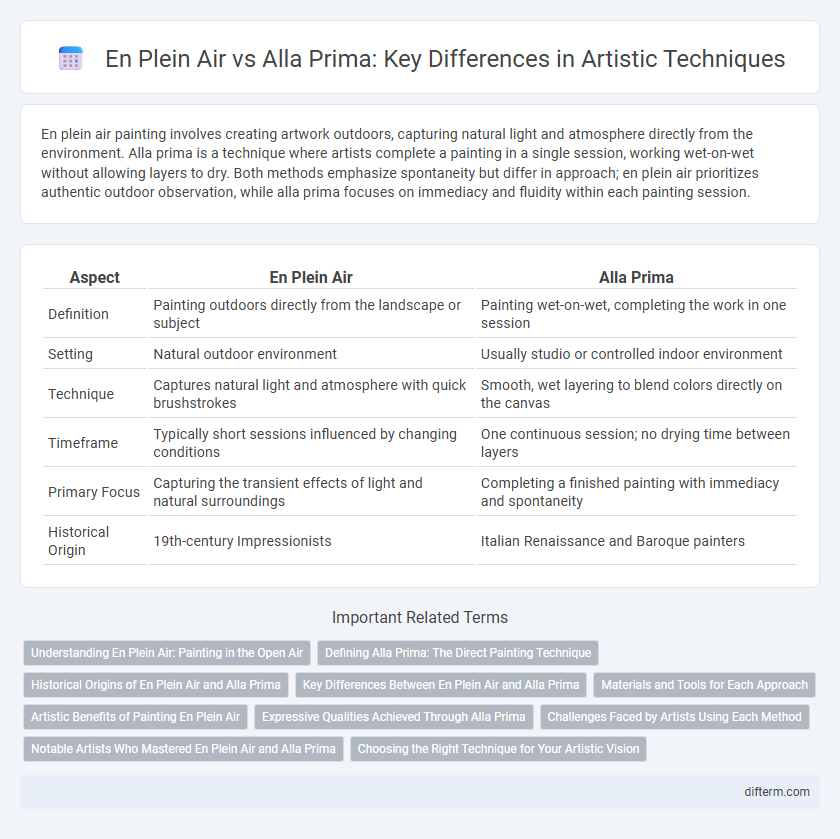En plein air painting involves creating artwork outdoors, capturing natural light and atmosphere directly from the environment. Alla prima is a technique where artists complete a painting in a single session, working wet-on-wet without allowing layers to dry. Both methods emphasize spontaneity but differ in approach; en plein air prioritizes authentic outdoor observation, while alla prima focuses on immediacy and fluidity within each painting session.
Table of Comparison
| Aspect | En Plein Air | Alla Prima |
|---|---|---|
| Definition | Painting outdoors directly from the landscape or subject | Painting wet-on-wet, completing the work in one session |
| Setting | Natural outdoor environment | Usually studio or controlled indoor environment |
| Technique | Captures natural light and atmosphere with quick brushstrokes | Smooth, wet layering to blend colors directly on the canvas |
| Timeframe | Typically short sessions influenced by changing conditions | One continuous session; no drying time between layers |
| Primary Focus | Capturing the transient effects of light and natural surroundings | Completing a finished painting with immediacy and spontaneity |
| Historical Origin | 19th-century Impressionists | Italian Renaissance and Baroque painters |
Understanding En Plein Air: Painting in the Open Air
En plein air painting emphasizes capturing natural light and atmospheric conditions by creating artwork outdoors, often resulting in vibrant, spontaneous compositions. This technique contrasts with alla prima, where artists complete paintings in a single session, typically in a studio setting, focusing on wet-on-wet paint application. Understanding en plein air requires recognizing its role in Impressionism and its ability to reflect real-time changes in environment and mood.
Defining Alla Prima: The Direct Painting Technique
Alla prima, also known as direct painting, is a technique where artists complete a work in a single session while the paint is still wet, allowing for spontaneous and expressive brushwork. This method contrasts with en plein air, which emphasizes painting outdoors but can involve multiple layers and drying times. Alla prima demands a confident approach and mastery of color blending, often resulting in vibrant, fresh compositions that capture the immediacy of the subject.
Historical Origins of En Plein Air and Alla Prima
En plein air painting originated in the 19th century with the Impressionists, who sought to capture natural light and atmosphere by working outdoors directly on the landscape. Alla prima, an older technique dating back to the Renaissance, involves applying wet paint layers in one session to create a finished piece without waiting for drying. Both methods revolutionized artistic expression by emphasizing immediacy and spontaneity, yet en plein air focuses on outdoor observation while alla prima centers on swift execution.
Key Differences Between En Plein Air and Alla Prima
En plein air painting emphasizes capturing natural light and atmosphere by working outdoors, often over extended sessions to observe changing conditions. Alla prima involves completing a painting in a single, spontaneous session, focusing on immediacy and fresh brushwork without layering or drying time. The key differences lie in setting, technique, and timing: en plein air prioritizes environmental observation and slower execution, while alla prima centers on swift, direct application of paint.
Materials and Tools for Each Approach
En plein air painting requires portable materials such as lightweight easels, watercolor or acrylic sets, and durable sketchbooks to accommodate outdoor conditions and changing light. Alla prima technique favors oil paints with fast-drying mediums, sturdy canvases, and a limited palette of brushes designed for swift, confident application in a single session. Both approaches demand tailored tools that enhance flexibility and efficiency, reflecting the artist's interaction with the environment and immediacy of execution.
Artistic Benefits of Painting En Plein Air
Painting en plein air offers artists direct engagement with natural light, color, and atmosphere, fostering a heightened sensitivity to changing environmental conditions. This immediacy enriches the authenticity and vibrancy of landscapes, enhancing observational skills and spontaneity. En plein air painting cultivates a deeper connection to the scene, resulting in dynamic compositions that reflect real-time interplay between light and shadow.
Expressive Qualities Achieved Through Alla Prima
Alla prima painting delivers vibrant expressiveness by capturing spontaneous brushstrokes and fresh color blends directly on the canvas, preserving the artist's emotional immediacy. This technique's wet-on-wet application allows for dynamic texture and fluid transitions, enhancing the artwork's vitality and energy. The intense, direct engagement with the medium fosters a unique sense of presence and immediacy that defines the expressive qualities of alla prima.
Challenges Faced by Artists Using Each Method
Artists working en plein air face challenges such as rapidly changing natural light and unpredictable weather conditions that demand quick adaptation and efficient use of materials. Alla prima painters confront the difficulty of completing a painting in a single session, requiring precise brushwork and confident color mixing to achieve a cohesive composition before the paint dries. Both methods test an artist's technical skill and creative spontaneity but differ in environmental constraints and timing pressures.
Notable Artists Who Mastered En Plein Air and Alla Prima
Claude Monet and Pierre-Auguste Renoir are seminal figures who mastered en plein air painting, capturing natural light and landscapes with vivid brushstrokes characteristic of Impressionism. John Singer Sargent excelled in alla prima technique, completing portraits in a single session with fluid, confident strokes that emphasize spontaneity and immediacy. Winslow Homer combined both methods, utilizing en plein air to study nature directly and alla prima to execute dynamic seascapes swiftly and expressively.
Choosing the Right Technique for Your Artistic Vision
En plein air painting immerses artists in natural light and environment, capturing shifting atmospheric conditions with spontaneity, ideal for landscapes and dynamic scenes. Alla prima technique emphasizes completing a painting in one session with wet-on-wet application, fostering a fresh, expressive finish suited for portraits and bold color studies. Selecting between these methods depends on your artistic vision, desired immediacy, and interaction with the subject matter.
en plein air vs alla prima Infographic

 difterm.com
difterm.com